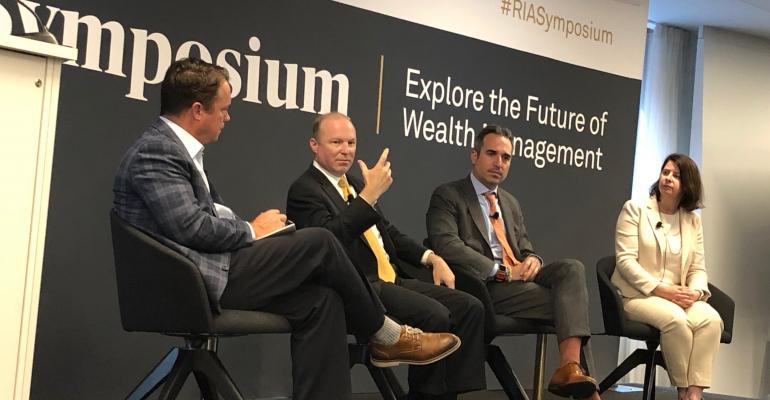Mergers and acquisitions activity in the registered investment advisor space is red-hot, with a record 176 transactions last year, up 20% from 2017, according to DeVoe & Company. But for advisors looking to get in on the action, the best way to improve a firm’s valuation is via organic growth, according to panelists at Pershing’s RIA Symposium in New York this week. And a few high-end RIAs speaking at the conference said their ancillary services, or family-office-like offerings, are driving that growth in their businesses.
“If you can’t get the organic strategy down, there’s no reason to enter into an inorganic strategy,” said Sean Keenan, director of advisor solutions at BNY Mellon’s Pershing.
Matt Fleissig, president of Pathstone, a single-family office with just under $15 billion in assets, said his firm has attracted the most business by offering a fully integrated package for clients, including accounting, bill pay and investments.
“We’re able, with the technology and scale that we’ve built, someone can come to us and say ‘I have 113 trusts with five tiers of ownership,’” Fleissig said. “We can report on it; we can handle all the bills. You have seven homes; we collect your mail; we scan your mail.”
They’ll even turn on and off clients’ cable for them. Offering such services that are not commoditized has created a stickiness factor for Pathstone.
Richard Hough, chairman and CEO of Silvercrest Asset Management, said he has lost none of the clients that use the firm’s family-office-like services, while they’ve lost some who use the firm only for investment advisory purposes. And all of the RIA's top 50 clients use their ancillary services, which account for more than 10% of Silvercrest’s revenue.
His firm prices those services on a project basis, not on an hourly basis. They’ll present the family with a proposal, come up with a solution for them and assess it after one year.
Liz Nesvold, managing director, head of asset and wealth management investment banking at Raymond James | Silver Lane, said it’s the cross-pollination of services that drives organic growth. For instance, a client may come in for tax planning and now the firm is doing their financial and estate planning, too. Maybe the firm also gets the investment management piece away from another advisor or advisors. This strategy can boost a firm’s valuation.
“We’ve seen it in businesses where they’re great at bringing somebody in through the door in one service, and really isn’t like a product sell,” Nesvold said. “Then they’re able to expand the wallet in terms of touching on so many parts of the family life. That’s where you know that that’s a sticky relationship.”
That said, when Nesvold was asked about the most meaningful services impacting valuations, she said investment management was the most scalable and highest margin contributor. Billing is a lower margin contributor.
“You do a great job on everything else and you forget to pay one Amex bill while they’re in Europe, and you’re in deep weeds there,” she said.
But more holistic services, like financial and estate planning, are important to buyers, she added. Advisors who have relationships with clients across the financial spectrum are perceived to have greater stickiness with them.
“Are you perceived as the gatekeeper of the relationship, or are you just a product in their asset allocation?” she asked. “If you’re just selling large-cap core to a family that has 59 other advisors, that’s a risky part of the business, and that valuation assessment is going to be a different threshold/price point if you were to transact than somebody else who has their whole arms around that relationship.”
Her advice? Understand the services you offer and the profitability of them; don’t underprice your services.
“People want to work with firms that are successful, that are growing, that are adding more human capital, and you cannot do that if you underprice your services,” she said.
A lot of advisors in this industry make a great living doing the “same old, same old.” But these firms are going to have to attract successors eventually.
“You’re really looking at the M&A event as a talent pool acquisition, more so than something to bulk up the firm,” Nesvold said. “But if you’re not growing organically, invariably you’re not going to be a buyer.”





